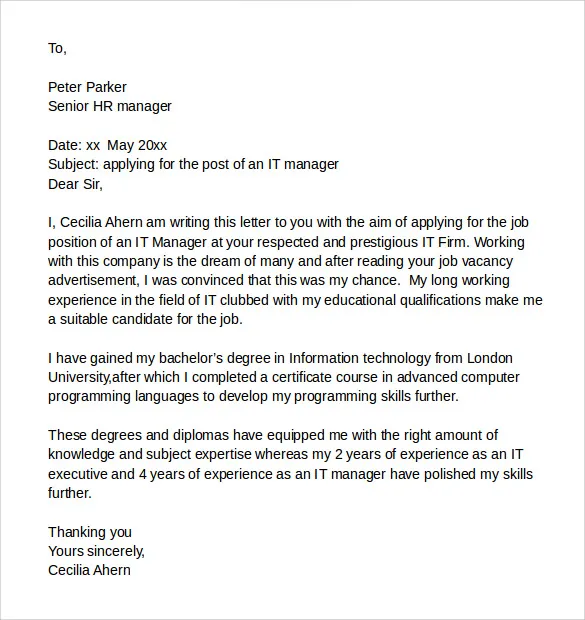Why an IT Cover Letter is Crucial
In the competitive world of Information Technology, a well-crafted cover letter is more than just a formality — it’s your first opportunity to make a lasting impression. While your resume provides a snapshot of your skills and experience, your IT cover letter allows you to tell a story, showcasing your passion, personality, and the specific value you can bring to a potential employer. It’s your chance to connect the dots between your qualifications and the requirements of the job, demonstrating why you’re the perfect fit. A strong cover letter highlights your accomplishments, explains your career goals, and emphasizes your understanding of the company’s needs. In essence, it sets the stage for your application, making the hiring manager eager to learn more and ultimately, to consider you for the position. Skipping this important step could mean missing out on your dream IT job, as a cover letter demonstrates professionalism, attention to detail, and your genuine interest in the role.
Showcasing Your IT Skills
Your IT cover letter should act as a spotlight, illuminating your most relevant skills and how they align with the job description. Begin by thoroughly reviewing the job posting and identifying the key skills and qualifications the employer is seeking. Then, strategically weave those skills into your cover letter, providing specific examples of how you’ve utilized them in past roles or projects. For instance, if the job requires experience with cloud computing, mention your hands-on experience with platforms like AWS, Azure, or Google Cloud, and describe any certifications you hold. Similarly, if the role involves network administration, highlight your expertise in areas like network security, troubleshooting, and system maintenance. Always prioritize the skills that are most critical to the position and provide tangible evidence of your abilities. This might include outlining projects where you successfully implemented network solutions or provided IT support. By showcasing your skills in a clear and concise manner, you immediately capture the hiring manager’s attention and demonstrate your ability to perform the job effectively.
Highlighting Technical Expertise
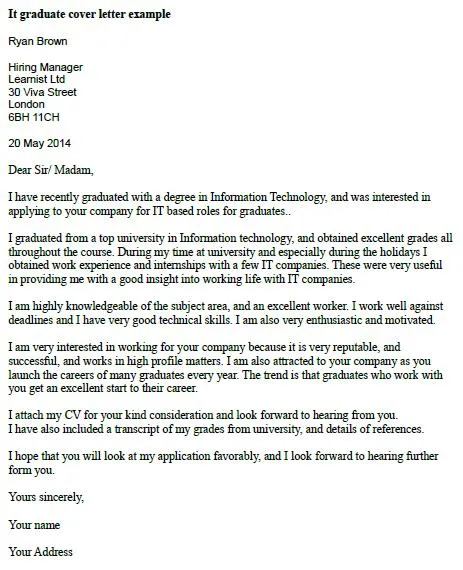
Beyond the general skills, an IT cover letter offers a prime opportunity to showcase your technical expertise. Go into detail about specific technologies, tools, and methodologies you’re proficient in. Mention any programming languages you are familiar with (e.g., Python, Java, C++), database management systems (e.g., SQL, MySQL, MongoDB), or operating systems (e.g., Windows, Linux, macOS). If the job requires experience with specific software or hardware, provide concrete examples of your experience. For instance, if you’re applying for a cybersecurity role, highlight your proficiency with security tools like firewalls, intrusion detection systems, and penetration testing techniques. Or, if you’re targeting a software development position, detail your experience with different development frameworks, version control systems (like Git), and software development lifecycle methodologies. Be specific and avoid vague statements; instead, demonstrate your technical expertise by providing concrete examples of how you’ve used your skills to solve problems, improve systems, or contribute to project success. This demonstrates that you’re not only familiar with these tools but also have a proven track record of applying them effectively.
Detailing Relevant Projects
One of the most effective ways to bring your skills to life is by detailing relevant projects you’ve worked on. These projects can be from previous employment, personal projects, or even academic assignments. When describing each project, be sure to include details about your role, the technologies you used, and the outcomes you achieved. For example, if you’re applying for a software development position, describe a project where you developed a web application, outlining the technologies involved (e.g., React, Node.js, and a database like MongoDB). Then, highlight your specific contributions to the project, such as writing key code modules, resolving critical bugs, and implementing new features. Quantify your achievements whenever possible by providing statistics like the number of users, the percentage of performance improvements, or the reduction in error rates. For IT support or system administration roles, you can describe projects where you successfully implemented new systems, streamlined IT processes, or resolved significant network issues. By detailing your projects, you transform abstract skills into concrete accomplishments, providing hiring managers with evidence of your capabilities.
Quantifying Your Achievements
Whenever possible, quantify your achievements to provide tangible evidence of your impact and value. Numbers speak volumes and can dramatically enhance the effectiveness of your cover letter. For instance, instead of saying that you improved network performance, quantify it by stating that you “increased network bandwidth by 20%,” or “reduced latency by 15%”. If you’ve worked on a project that saved the company money, specify the dollar amount. If you’ve streamlined a process, mention the amount of time you saved or the number of tasks you automated. For IT support roles, you could quantify your achievements by citing the number of tickets resolved per day, or the reduction in mean time to resolution. For software development roles, you can quantify your impact by the number of lines of code written, the number of bugs fixed, or the improvement in application performance. Quantifying your achievements gives hiring managers a clear picture of the value you bring to the table and highlights your ability to deliver tangible results, making your cover letter more persuasive.
Formatting Your IT Cover Letter
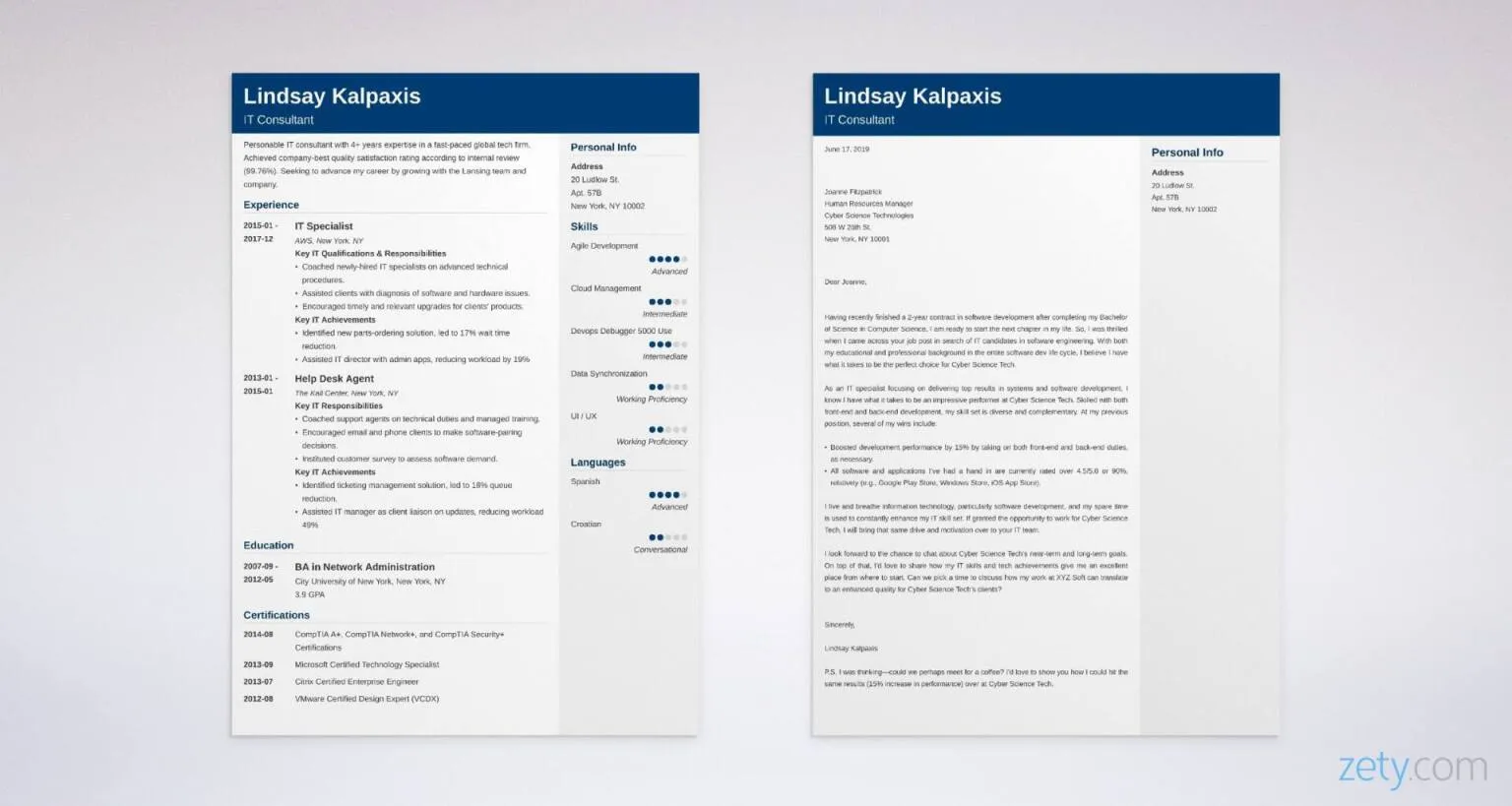
The format of your IT cover letter is just as important as its content. A well-formatted letter demonstrates professionalism and attention to detail, while a poorly formatted one can undermine your application. The letter should be concise, typically one page in length, and easy to read. Use a clean, professional font such as Arial, Calibri, or Times New Roman, and maintain a consistent font size (usually 11 or 12 points). Set your margins to one inch on all sides to provide ample white space, making the letter visually appealing. The structure should be logical, with clear sections and paragraphs. Use headings and bullet points to break up large blocks of text, making the information easy to scan and digest. Avoid excessive jargon or technical terms that the hiring manager may not understand. Ensure that your letter is free from grammatical errors and typos by proofreading it carefully. Remember, attention to detail is critical in IT, so your cover letter should reflect your commitment to accuracy and professionalism.
Key Sections to Include
A well-structured IT cover letter typically includes the following key sections: a header with your contact information, a professional salutation, an opening paragraph to grab attention, a few body paragraphs highlighting your skills and experience, and a closing paragraph with a clear call to action. These elements work together to present a cohesive and compelling narrative of your qualifications and interest in the role. Make sure you have all of the information ready before you begin to write the letter. Be sure to have the name of the person you need to address and make sure all of the contact information is accurate.
Header and Contact Information
Your header should include your full name, phone number, email address, and optionally, your LinkedIn profile URL or personal website. Place this information at the top of your cover letter, either in the left or right corner. Ensure your email address is professional, ideally using a combination of your first and last name, and that your LinkedIn profile is up-to-date and reflects your professional experience. Make sure you have the name of the hiring manager or the hiring team. This may take research on your end but it is important to make a personal connection with the recipient. If you can’t find a specific name, use a general greeting such as “Dear Hiring Manager” is acceptable.
Opening Paragraph: Grabbing Attention
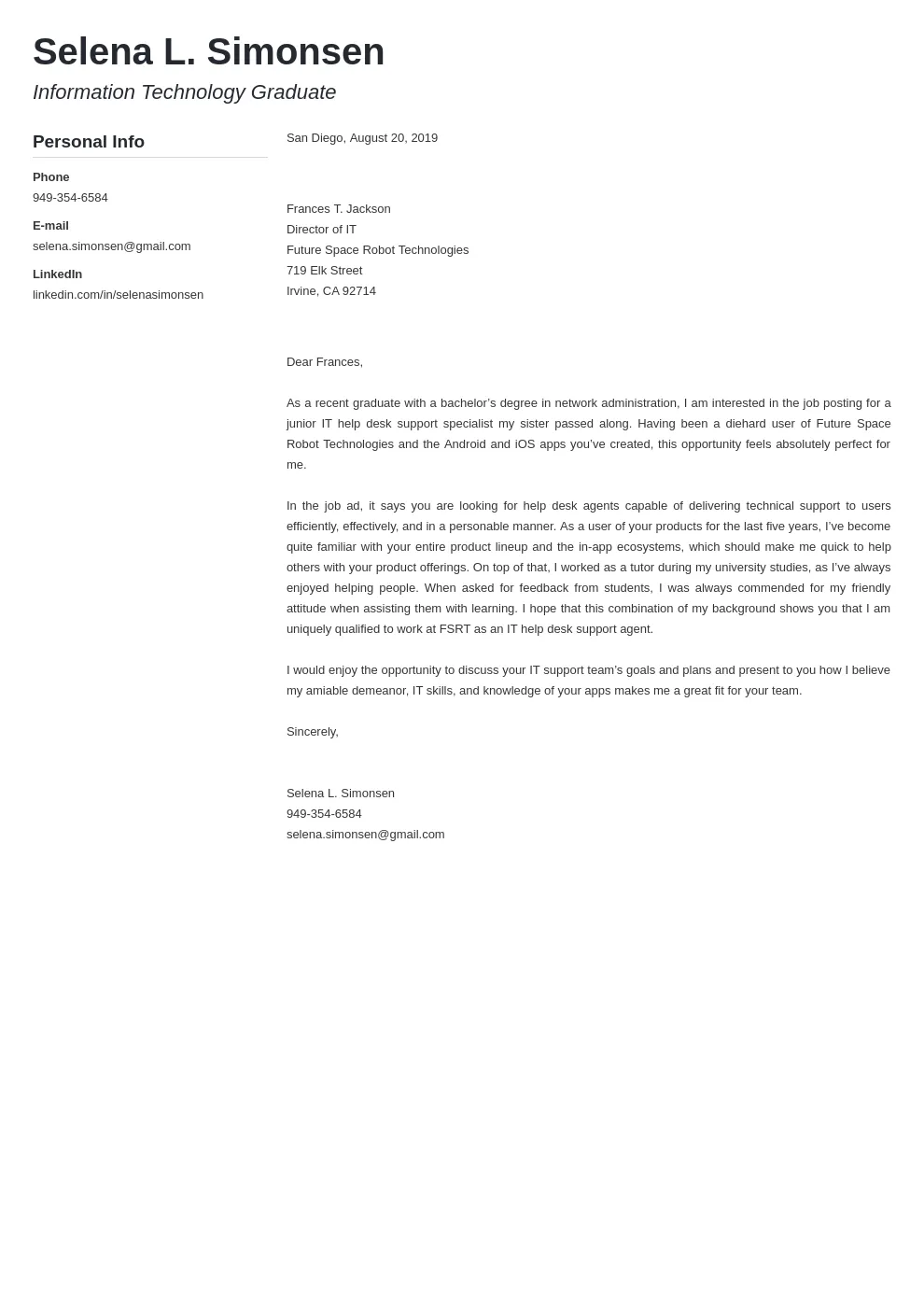
The opening paragraph is your chance to make a strong first impression, so it needs to be concise and compelling. Start by stating the specific position you’re applying for and where you saw the job posting. Then, immediately grab the reader’s attention by expressing your enthusiasm for the role and the company. Briefly highlight a key skill, experience, or achievement that directly aligns with the job requirements. This demonstrates your immediate understanding of the position and your ability to provide value. Avoid generic opening statements like “I am writing to express my interest…”; instead, make a confident statement that captures the essence of your candidacy and piques the hiring manager’s interest. Mentioning a project that you’re excited about or relating a relevant experience can go a long way towards creating intrigue.
Body Paragraphs: Demonstrating Value
The body paragraphs are where you demonstrate your value and make your case for why you are the best candidate. Structure these paragraphs to highlight your relevant skills, experience, and accomplishments. Connect your skills to the job requirements by using the same keywords used in the job description, but don’t simply restate your resume. Elaborate on your experiences by providing specific examples of what you’ve done, how you did it, and the results you achieved. Focus on the impact you made in previous roles or projects, using data to back up your claims. Consider using the STAR method (Situation, Task, Action, Result) to structure your responses, which helps provide a clear, concise, and impactful narrative. Use these paragraphs to showcase your problem-solving skills, your technical expertise, and your ability to work both independently and collaboratively. Tailor the information to the specific requirements of the job to show that you’re a strong match.
Closing Paragraph: Call to Action
The closing paragraph is your final opportunity to leave a lasting impression. Reiterate your interest in the position and express your enthusiasm for the opportunity to contribute to the company. Summarize your key qualifications and reiterate your value proposition. Include a clear call to action, such as inviting the hiring manager to contact you for an interview or to discuss your qualifications further. Thank the reader for their time and consideration, and end with a professional closing, like “Sincerely” or “Best regards,” followed by your name. Make sure your contact information is included here, once again.
Tips for IT Cover Letter Success
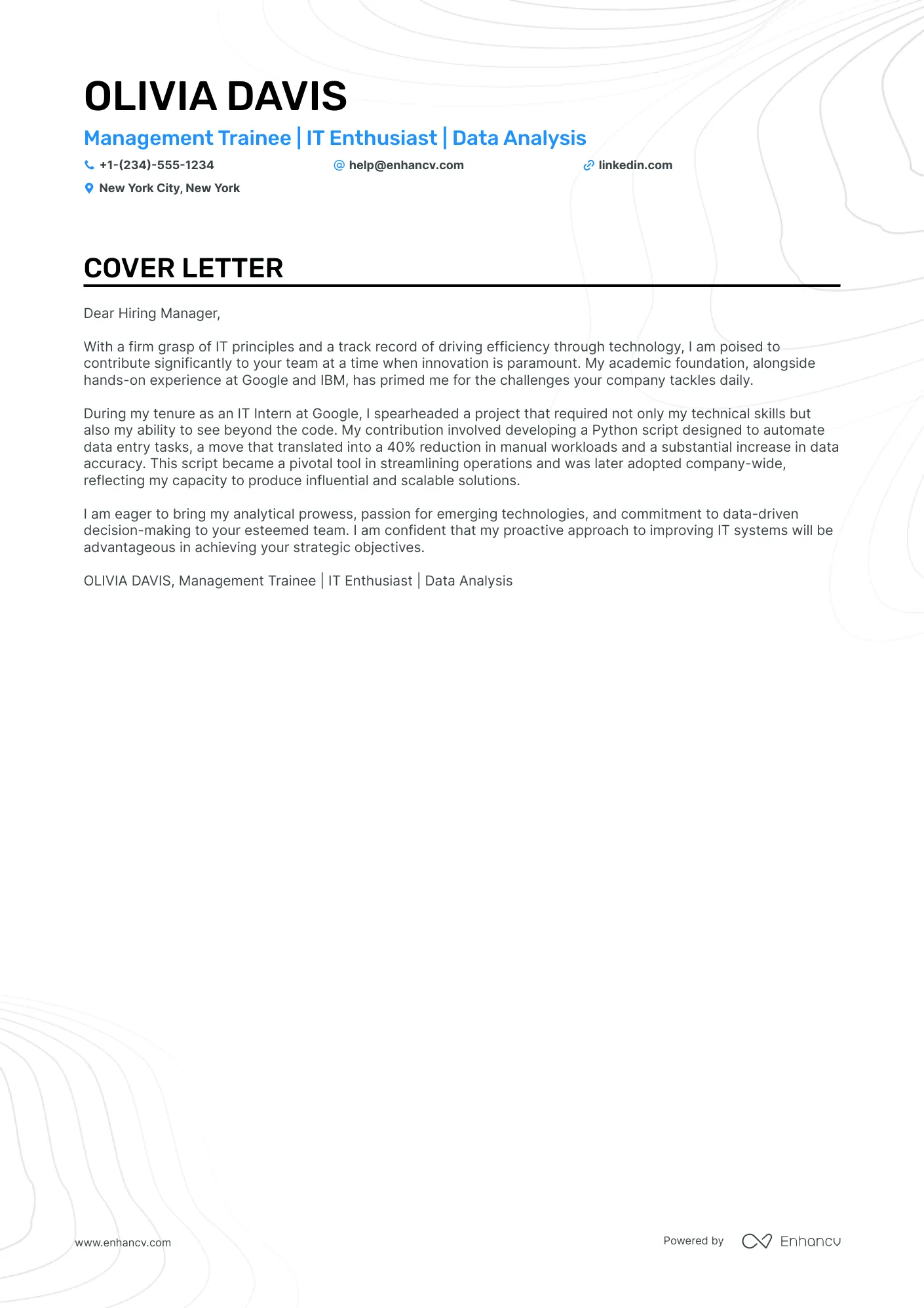
To maximize your chances of getting hired, consider these additional tips to ensure your IT cover letter stands out from the crowd. Take the time to do your research and put in the work. Remember that your letter should not be a generic copy. Be sure that you are taking the time to read the job description and craft the letter to the needs of the company. Proofread everything before submitting.
Tailoring to the Job Description
Avoid using a generic cover letter that you send to every company. Each cover letter should be tailored to the specific job and company you’re applying to. This shows that you’ve done your research and that you genuinely want the job. Carefully review the job description, identifying the key requirements, skills, and keywords. Then, customize your cover letter to directly address those requirements, highlighting your relevant experiences, accomplishments, and skills. Reference specific projects, tools, and technologies mentioned in the job description. Show how your qualifications and experience align with the company’s needs and values. By tailoring your cover letter, you demonstrate that you are a thoughtful, prepared candidate who pays attention to detail.
Using Action Verbs
Use strong action verbs to start your sentences and highlight your accomplishments. Action verbs make your cover letter more dynamic and engaging, showcasing your proactive approach and accomplishments. Instead of passive phrases like “Responsible for,” use active verbs like “Managed,” “Developed,” “Implemented,” “Resolved,” “Optimized,” or “Led.” Action verbs help create a sense of movement and demonstrate your ability to take initiative and make things happen. Make sure that each verb you choose reflects your actual role and contributions. A well-chosen verb at the start of a sentence can draw the reader’s attention and make a significant impact.
Proofreading and Editing
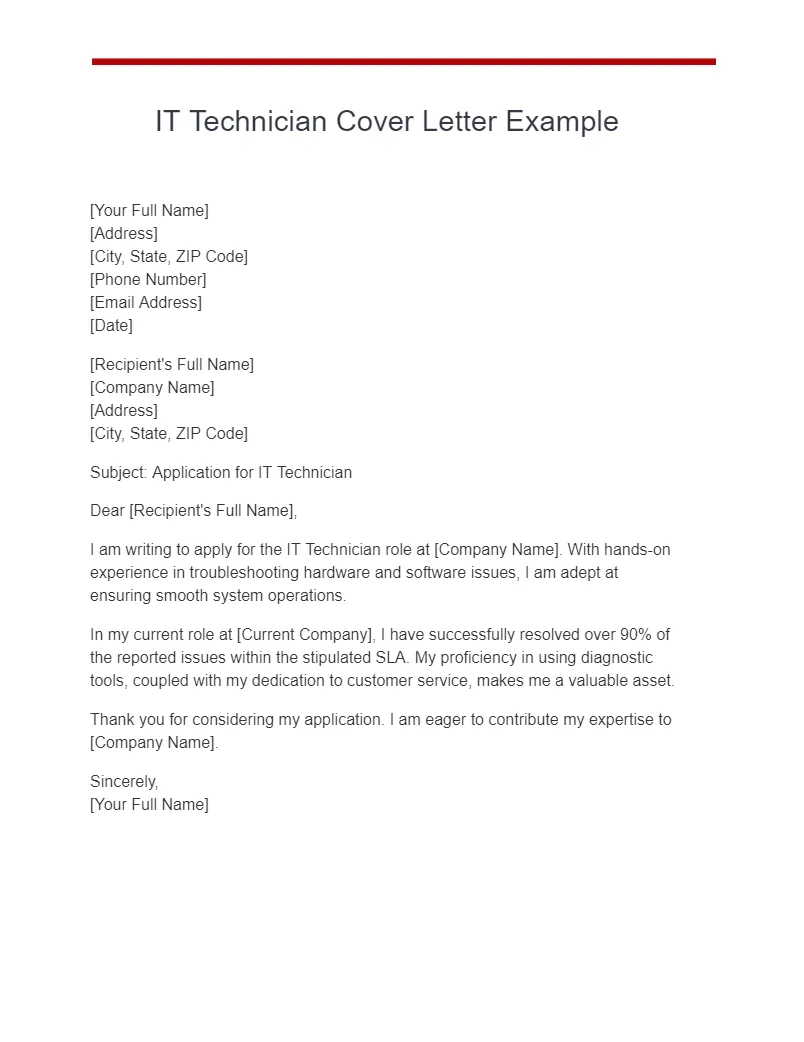
Proofreading and editing your cover letter are absolutely essential. Errors in grammar, spelling, and punctuation can create a negative impression, suggesting a lack of attention to detail and professionalism. Carefully review your letter for any mistakes, and consider having a friend, family member, or career counselor review it as well. Read the letter aloud to catch any awkward phrasing or sentences that don’t flow smoothly. Make sure the formatting is consistent, and all the information is accurate. A polished cover letter shows that you care about presenting yourself professionally and increases your chances of getting hired. An easy-to-follow, error-free document will provide the best first impression.
IT Cover Letter Examples and Templates
Utilizing cover letter examples and templates can serve as a helpful guide when writing your own. These resources can show you how to structure your letter, what kind of information to include, and how to showcase your skills and experience effectively. However, it’s critical not to simply copy and paste from a template, but rather to adapt it to your specific situation and tailor it to each job application. Customize the language to reflect your unique qualifications, skills, and accomplishments. The goal is to create an authentic and compelling cover letter that reflects your individual brand and the value you offer to the employer. Below, you will find examples to help you. Please adapt them to fit you and the requirements.
Example 1 Systems Administrator
Dear [Hiring Manager Name],
I am writing to express my keen interest in the Systems Administrator position at [Company Name], as advertised on [Platform]. With over five years of experience in managing and maintaining complex IT infrastructures, I am confident that my skills and experience align perfectly with the requirements of this role.
In my previous role at [Previous Company], I was responsible for managing and maintaining Windows and Linux server environments, ensuring high availability and optimal performance. I have extensive experience with virtualization technologies, including VMware and Hyper-V, as well as experience with cloud services. I consistently reduced system downtime by 15% through proactive monitoring and maintenance, also streamlined server patching by implementing automation tools, saving the company an average of 10 hours per month.
I am proficient in scripting languages like PowerShell and Python, which I used to automate various administrative tasks. I am adept at troubleshooting network issues, implementing security protocols, and providing excellent technical support to end-users. My certifications include [Relevant Certifications, e.g., CompTIA Server+, Microsoft Certified: Azure Administrator].
I am particularly excited about [Company Name]’s commitment to [Company Value/Mission]. I am eager to bring my expertise and dedication to your team. I am available for an interview at your earliest convenience. Thank you for your consideration.
Sincerely, [Your Name]
Example 2 Software Engineer

Dear [Hiring Manager Name],
I am writing to express my enthusiastic interest in the Software Engineer position at [Company Name], as advertised on [Platform]. With a solid foundation in software development and a passion for creating innovative solutions, I am confident that I can make a significant contribution to your team.
Throughout my career, I have been involved in the full software development lifecycle, from requirements gathering to deployment and maintenance. I have hands-on experience with various programming languages, including Java, Python, and C++. In my previous role at [Previous Company], I designed and developed a web application using React and Node.js, which resulted in a 20% increase in user engagement. I have experience with Agile methodologies and have a strong understanding of software design principles and best practices.
I am proficient in using version control systems like Git and have experience working with databases such as MySQL and MongoDB. I am eager to learn new technologies and collaborate with other developers. My expertise is further validated by my [Relevant Certifications, e.g., AWS Certified Developer].
I am particularly impressed by [Company Name]’s work on [Specific Project/Product]. I am looking forward to the opportunity to contribute to your innovative projects. Thank you for your time and consideration.
Sincerely, [Your Name]
Example 3 IT Support Specialist
Dear [Hiring Manager Name],
I am writing to express my interest in the IT Support Specialist position at [Company Name], as advertised on [Platform]. With a proven track record of providing excellent technical support and a strong understanding of IT systems, I am confident that I can quickly become a valuable asset to your team.
In my previous role at [Previous Company], I was responsible for providing technical support to end-users, resolving hardware and software issues, and managing IT assets. I have experience with troubleshooting network connectivity problems, installing and configuring software, and maintaining computer systems. I have a proven ability to resolve user issues effectively, which led to a 95% user satisfaction rate. I am also proficient in using help desk ticketing systems and documenting technical procedures.
I am passionate about providing exceptional customer service and have excellent communication skills. I am eager to learn new technologies and collaborate with other IT professionals. My certifications include [Relevant Certifications, e.g., CompTIA A+, Microsoft Certified Professional].
I am excited about the opportunity to join [Company Name] and help ensure the smooth operation of its IT infrastructure. I am available for an interview at your earliest convenience. Thank you for your time and consideration.
Sincerely, [Your Name]
Common Mistakes to Avoid
Avoid these common mistakes to ensure your cover letter does not work against you. Ensure you have double-checked everything and followed best practices. Mistakes make the applicant look unprofessional and may diminish the chances of being hired.
Generic Cover Letters
Avoid using a generic cover letter. A generic cover letter is one that is not tailored to the specific job or company. It does not showcase your genuine interest in the role or your understanding of the company’s needs. Hiring managers can easily spot generic cover letters, which signal a lack of effort and attention to detail. Instead, create a customized cover letter for each job application, demonstrating your understanding of the specific requirements of the role and how your skills and experience align with them. Tailoring your cover letter shows that you are genuinely interested in the position and the company, increasing your chances of getting an interview.
Typos and Grammatical Errors
Typos and grammatical errors are a major red flag for hiring managers. These errors can create the impression that you are careless, inattentive to detail, and unprofessional. Proofread your cover letter carefully before submitting it, and use a grammar and spell-checking tool to catch any mistakes. Reading your cover letter aloud can also help you identify awkward phrasing or sentences. Consider asking a friend or family member to review your cover letter for any errors that you may have missed. By taking the time to ensure your cover letter is error-free, you present yourself as a competent, detail-oriented professional.
Focusing on Yourself Too Much
Avoid focusing too much on yourself and not enough on how you can contribute to the company’s success. While it’s important to highlight your skills and accomplishments, the cover letter should ultimately focus on how you can meet the company’s needs and add value. Frame your skills and experiences in terms of the benefits you can bring to the employer. For example, instead of saying “I am proficient in Python,” you could say “My proficiency in Python has enabled me to automate key processes, reducing operational costs by 15%.” Focus on how your skills and experiences align with the company’s needs and how you can contribute to their goals. A cover letter should always show the benefits of you being on the team.
Finalizing and Submitting Your Cover Letter
Once you’ve written and edited your IT cover letter, ensure that it’s finalized and submitted correctly. Be sure to use the correct format and to follow the instructions that the hiring team or the company provided. If there are any requirements such as a certain file type, format, or how it should be addressed, make sure you adhere to those instructions. This final step is what will ensure you are able to get an interview.
